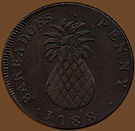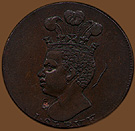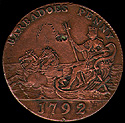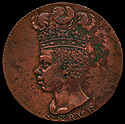The Barbados Coppers 1788, 1792
1788 Penny
obverse |
|
reverse |
| |||
Penny 1788 Barbados Pridmore 13, KM-Tn8
Obverse: BARBADOES . PENNY . 1788 .
Reverse: I . SERVE
Weight: 209.6 g (13.58 grams) Diameter: 33.1 mm
Comments: There is no consensus on which side is the obverse. Pridmore considers the portrait the obverse while Krause-Mishler refers to the pineapple side as the obverse. As the portrait is not a royal image and the coin is known as the "Pineapple" copper I have called the pineapple side the obverse. This is what Pridmore identifies as Barbados no. 13, identified by the die break behind the portrait. He lists five varieties of this token plus four restrikes and a Twentieth century countermarked variety. Krause-Mishler calls this a Type III variety, having a large large pineapple on the obverse and a large portrait on the reverse. Our example has a deep planchet void to the lower right of the bust. Pridmore attributes these dies to John Milton, just before he joint the Royal mint. Milton was assistant engraver at the Royal Mint 1789-1798.
Provenance: Donated to Notre Dame in 1887 as part of a 2,300 item coin collection (see: The Notre Dame Scholastic, vol. 21 (September 1887) 45.
1792 Series
obverse |
|
reverse |
| |||
Halfpenny 1792 Barbados Pridmore 17, KM-Tn9
Obverse: BARBADOES . HALF[PENNY] 1792
Reverse: [I . S]ERVE
Weight: 79.7 g (5.16 grams) Diameter: 24.2 mm
Comments: See the item above for the obverse - reverse distinction, which also pertains to the "Neptune" varieties. This is the only original halfpenny variety listed in Pridmore; he also lists a later restrike, which is on a thick planchet with an average weight of 157.7 grains. This example was struck off center, somewhat to the left cutting a part of the legend from the top on the obverse and part of the bottom legend on the reverse.
Provenance: Donated to Notre Dame in 1887 as part of a 2,300 item coin collection (see: The Notre Dame Scholastic, vol. 21 (September 1887) 45.
obverse |
|
reverse |
| |||
Penny 1792 Barbados Pridmore 15, KM-Tn10
Obverse: BARBADOES PENNY 1792
Reverse: I . SERVE
Weight: 197.0 g (12.77 grams) Diameter: 30.9 mm
Comments: Pridmore lists two varieties, the one shown above and Barbados 16, which differs in that on the reverse figure the top row of the coronet is plain rather tha corded as in the above example and the large jewels are incuse. The Krause-Michler example of this coin with a stop between "BARBADOES" and "PENNY", which according to Pridmore (his no. 23) is a restrike.
There is a large planchet void with several smaller voids and some scratches on the obverse field near the trident as well as a small void below the date and on the reverse there are several small planchet voids. The border is partially engrailed. Pridmore notes there is an initial M at the neck runcation on the portrait, for John Milton the engraver at the Royal Mint who cut these dies.
Provenance: Donated to Notre Dame in 1887 as part of a 2,300 item coin collection (see: The Notre Dame Scholastic, vol. 21 (September 1887) 45.
Latest revision: December 23, 1999
| Blacksmith Coppers | Section Contents | Bermuda Copper |
|
For viewing tips and information on optimal computer settings click
here.
For questions or comments contact Special Collections by: |





